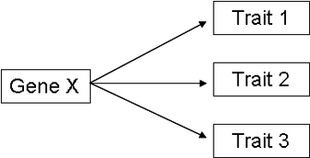==

When one gene affects several different traits. http://mumtazticloft.com/PigeonGenetics1.asp
Pleiotropy==
Pleiotropy: occurs when one gene influences multiple phenotypic traits (Vitti, Cho, Tishkoff, & Sabeti, 2011).
In genetics, pleiotropy is the property in which a gene can affect more than one function or phenotype in an organism. Studies have shown that genes can have varying degrees of pleiotropy and that, on average, deleting genes with higher degrees of pleiotropy has harmful effects on the organism (Guillaume & Otto, 2012). This property can be seen as a limitation on evolution because most mutations result in deletions and therefore, reduce the organism's ability to adapt (orr, 2000). Understanding the mechanisms and implications of pleiotropy is important in terms of evolution because evolution can be inhibited by the expression of unfavorable phenotypic traits through the increased pleitropic effects of a gene. For this reason, complex organisms, such as vertebrates, have generally low levels of pleiotropy because genes mostly affect a few traits (Wagner & Zhang, 2011).
The Nature of Pleiotropy[]

Figure 1: Diagram of pleiotropy. A pleiotropic gene is a single gene that controls more than one trait. © 2008 Nature Education All rights reserved.
There are various reasons why a gene may have pleiotropic effects, such as: 1) different enzymatic products coded by that gene catalyze different reactions 2) the varying degrees in which an enzymatic product reacts different substrates
3) various allocations of the same product to two different functions or organelles 4) different properties of the same gene product
Each of these activities are balanced out by activity costs in other areas. As a result, this system has evolved in such a way that trade-offs are observed and this determines the degree of pleiotropy in genes. Weak trade-offs imply minor losses in functionality of the primary trait when gaining a secondary trait. Studies have shown that selection favors situations where pleiotropic genes improve gene function at little costs to other functions. This concept is responsible for an organism's fitness and phenotypic strength. The more highly expressed genes consist of a greater degree of pleiotropy and suggest a coevolution between pleiotropy and gene expression (Guillaume & Otto, 2012) .
Examples of Pleiotropy[]
Gregor Mendel's observation that colorless seed coats in pea plants yielded white flowered plants with no pigmentation on their avils and that colored seed coats produced plants with colored flowers and colored axils. In this case, the gene which determined seed coat color was always responsible for flower and axil coloration as well.
Wing development in fruit flies (Drosophila) is controlled by a gene which a

Figure 2 : Poncho, a chicken with the frizzle gene Courtesy of Jennifer Key. All rights reserved.
lso changes the number of egg string in the female's ovaries, the position of scutellum bristles, and decreases the life span.
The gene that produces feathers curling outward rather than laying flat in chickens, known as the frizzle gene, was also found responsible for abnormal body temperatures, higher metabolic and blood rates, greater digestive capacity, and few egg laying counts.
There are many examples of pleiotropy in humans, including some associated with various diseases. Marfan syndrome is caused by one gene and results in gauntness, limb elongation, increased suscceptibility to heart disease, and other abnormal traits. Phenylketonuria is another disease caused by a pleiotropic gene. This gene causes mental retardation, eczema, and pigment defects. While these are sometimes detrimental to an organism's fitness, the phenotypic effects of pleitropic genes allows us to understand and map the functions of specific genes (Lobo, 2008).
Sources:
Guillaume, F. & Otto, S. 2012. Gene Functional Trade-Offs and the Evolution of Pleiotrpy. Genetics, 192, 1389-1409.
Lobo, I. 2008. Pleiotropy: One Gene Can Affect Multiple Traits. Nature Education, 1(1).
Orr, H. 2000. Adaptation and the cost of complexity. Evolution, 54, 13–20.
Vitti, J., Cho, M., Tishkoff, S., & Sabeti, P. 2011. Human Evolutionary Genomics: Ethical and Interpretive Issues. Trends in Genetics, 28(3), 137-145.
Wagner, G., & Zhang, J. 2011. The pleiotropic structure of the genotype-phenotype map: the evolvability of complex organisms. Nature Reviews Genetics, 12, 204-213.